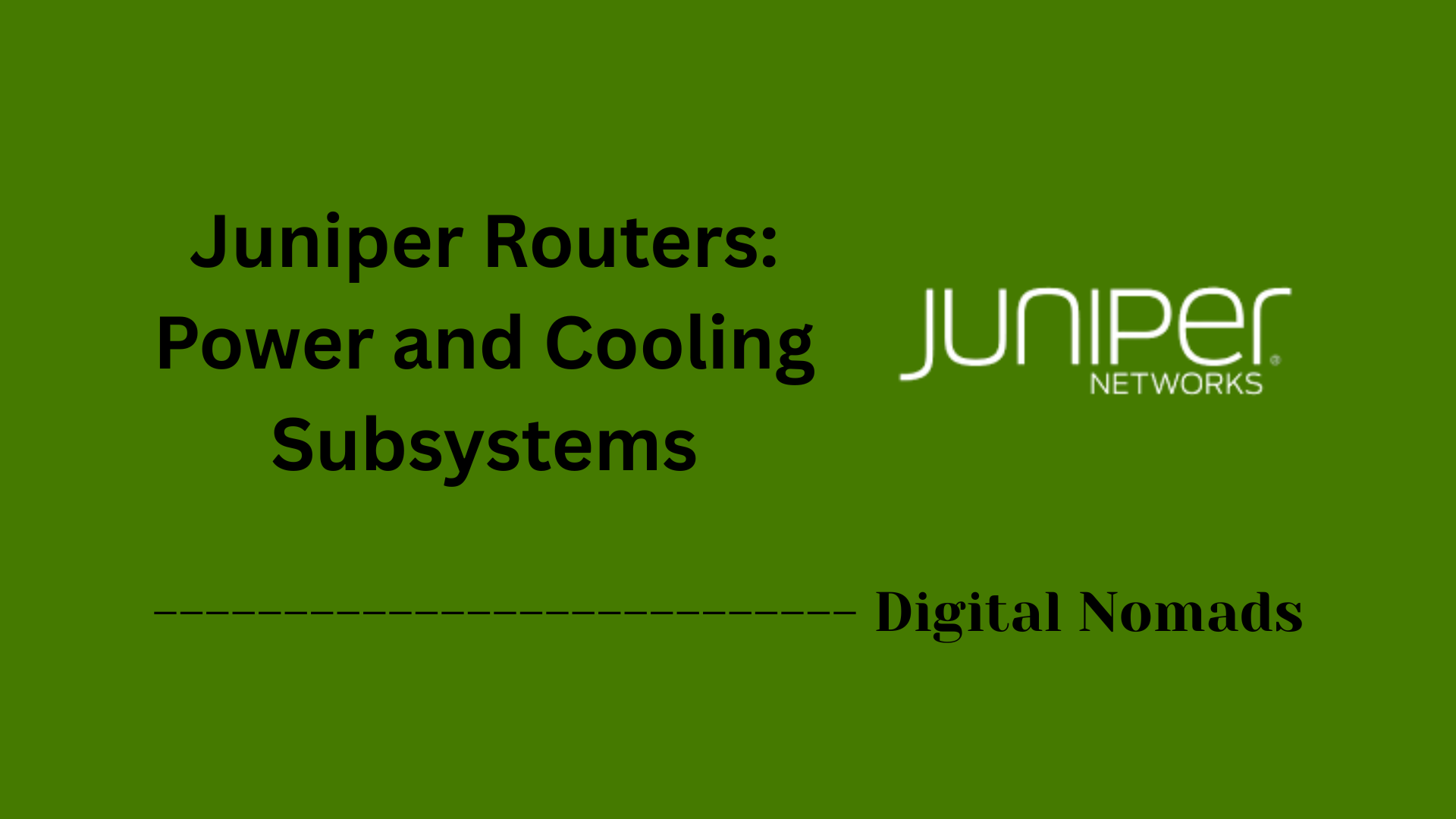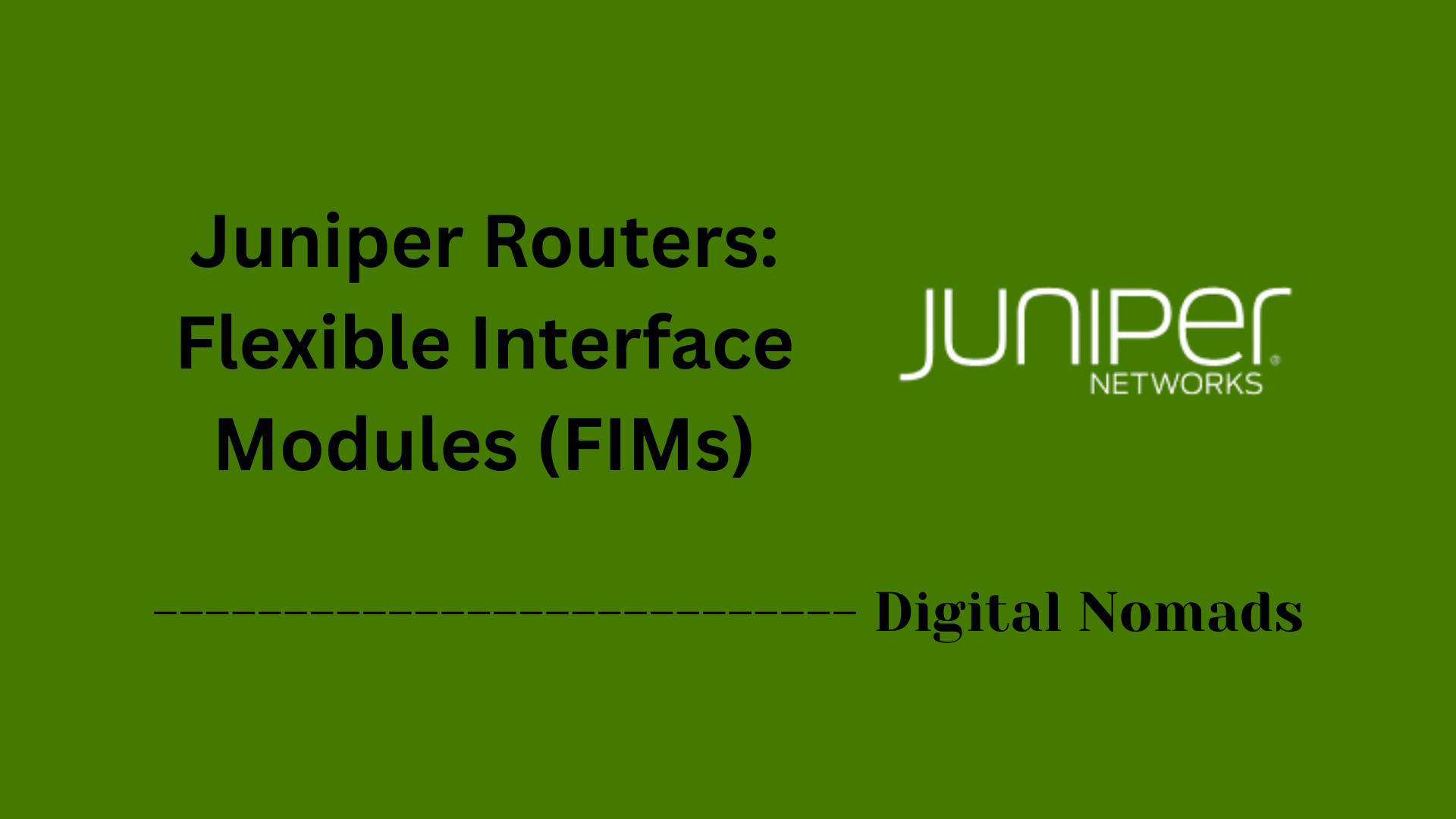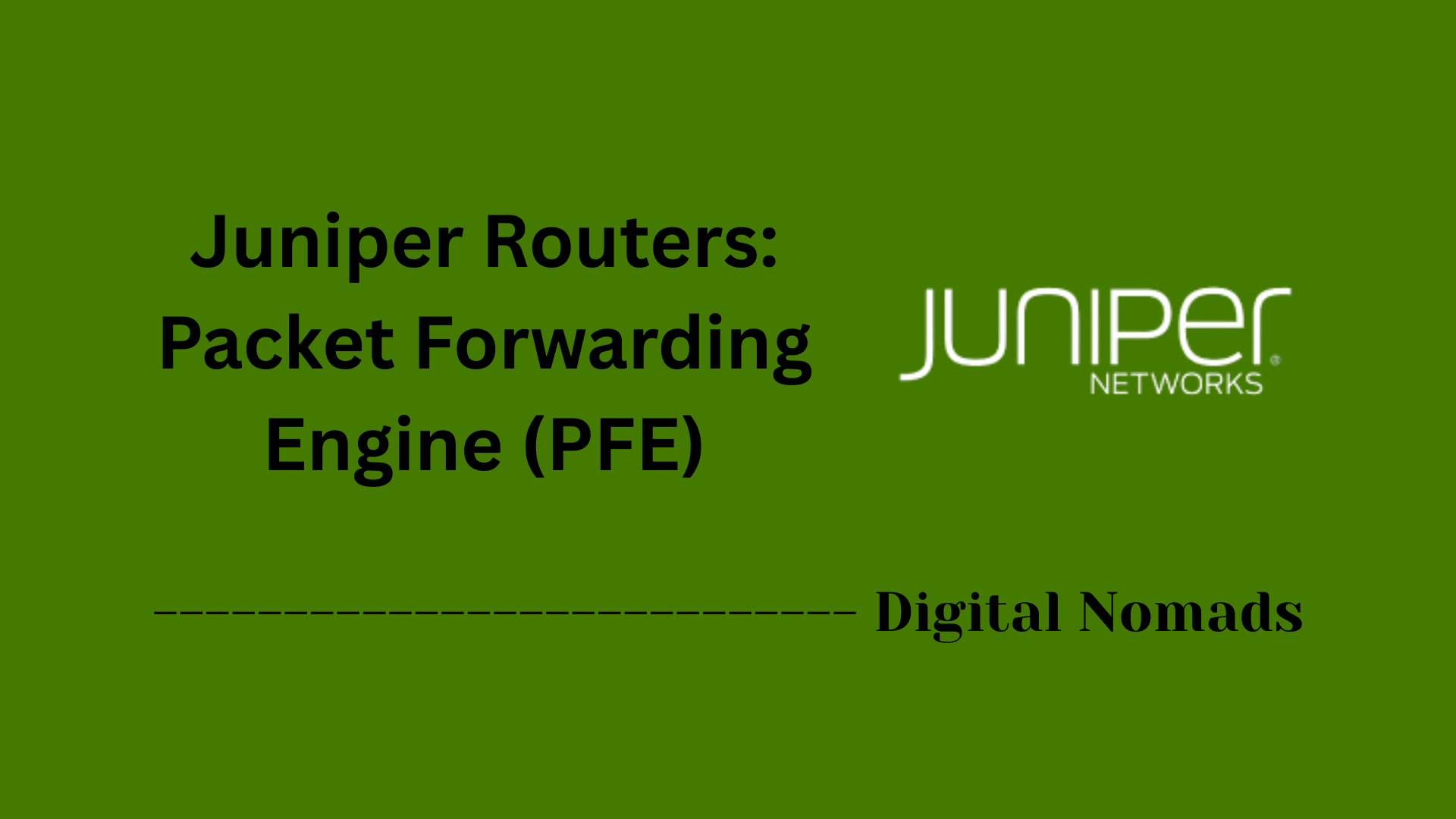Table of Contents
- Overview
- Supported Security Services and Functions
- Cryptographic Standards and Compliance
- Key Roles and Responsibilities
- Compatibility and Integration
- Common Use Cases
- Conclusion
Juniper Routers: Advanced Security Modules – Overview
What Are Juniper Routers: Advanced Security Modules?
Juniper Routers equipped with Advanced Security Modules are specialized network devices designed to deliver high-performance routing and robust, enterprise-grade security within a single, integrated platform. These security modules extend traditional router functionality by embedding advanced features such as firewalls, intrusion prevention, encryption, and smart threat detection directly into the routing hardware.
This approach means organizations do not need separate, standalone security appliances for critical protections—security is built-in and operates alongside Juniper’s reliable routing capabilities.
Why You Need to Know About Advanced Security Modules
Modern organizations face an increasingly complex threat landscape, with risks ranging from malware and ransomware attacks to data theft, network breaches, and regulatory non-compliance. As more applications move to the cloud and as physical boundaries blur with remote work and hybrid IT, safeguarding data “in transit” becomes as important as protecting it “at rest.”
Key reasons to consider Juniper’s Advanced Security Modules:
- Unified Protection: Streamlines security policy implementation by consolidating routing and security, reducing management complexity and human error.
- Compliance & Standards: Meets stringent regulatory requirements with features such as FIPS-validated cryptography and strong access controls.
- Performance at Scale: Handles high-speed traffic without compromising on security, making it suitable for enterprises, service providers, and cloud environments.
- Future-Proofing: Supports evolving network architectures, including zero trust, SASE (Secure Access Service Edge), SD-WAN, and hybrid multi-cloud, ensuring long-term relevance.
How It Works: Key Concepts and Mechanisms
Advanced Security Modules in Juniper Routers operate by integrating a suite of protective services directly into the device’s operating system (Junos OS). Here’s how the core mechanisms function:
- Stateful Inspection & Firewalls: The module monitors network traffic sessions, validating each packet against security policies and blocking unauthorized or suspicious activity before it traverses the network.
- Encryption & VPNs: Built-in cryptography enables secure VPN tunnels for remote access and site-to-site connectivity, utilizing strong algorithms like AES and robust key management.
- Intrusion Prevention & Detection: The system analyzes traffic in real time, comparing against known threat signatures and behaviors, and can automatically block or quarantine malicious flows.
- Automated Threat Intelligence: Dynamic updates and cloud-delivered threat feeds ensure defenses stay current as attack techniques evolve, allowing the router to adapt and respond automatically.
- Integrated Management: Security controls—such as policy enforcement, logging, and compliance auditing—are managed centrally through Junos OS and supporting orchestration tools.
By embedding security directly into network routing paths, Juniper Routers with Advanced Security Modules deliver comprehensive, efficient, and scalable protection where it is needed most: at the very core of organizational connectivity.
Supported Security Services and Functions
Juniper Routers are equipped with advanced security modules that deliver a suite of network protection services essential for modern enterprise and data center environments. Below, you’ll find the key security services and a summary of their supported functions:
- Stateful Firewall: Monitors and manages the state of active connections, enforcing policy controls for both inbound and outbound network traffic. Ensures granular control at the session layer, providing effective network segmentation.
- Advanced NAT (Network Address Translation): Includes persistent NAT and DNS doctoring, allowing seamless translation of address spaces to ensure secure, application-aware connectivity across networks.
- VPN Services (IPsec, ADVPN, Hub-and-Spoke): Provides secure, encrypted tunnels for site-to-site and remote user connectivity. Enables flexible architectures, including standard IPsec, dynamic ADVPNs, and scalable hub-and-spoke deployments.
- Intrusion Detection and Prevention (IDS/IPS): Actively monitors, detects, and blocks malicious traffic and potential threats using signature-based and behavioral analysis.
- Anomaly and Threat Detection: Identifies unusual patterns, flagging suspicious behaviors and helping administrators respond proactively to emerging threats.
- Automated Threat Mitigation: Leverages real-time intelligence and security automation to respond immediately to detected threats, minimizing exposure and recovery times.
- Flow and Session Monitoring: Provides high-performance telemetry and analytics for traffic flows and session-level events, enabling robust network monitoring and audit trails.
- High Availability (HA): Multi-node redundancy and failover ensure continuous protection and uninterrupted service for mission-critical deployments.
Supported Platforms: These security functions are available across various Juniper router models, including the MX Series, SRX Series, and Session Smart Routers. Platform support may vary by feature and deployment requirements.
Cryptographic Standards and Compliance
Juniper Routers adhere to industry-leading cryptographic standards to ensure the confidentiality, integrity, and authenticity of data within enterprise and service provider networks. Their security modules are validated to comply with FIPS 140-2 and support recognized algorithms and compliance requirements as outlined below:
- FIPS 140-2/140-3 Validation: Juniper's cryptographic modules are validated to Federal Information Processing Standards (FIPS) 140-2 or 140-3, depending on the platform and Junos OS version. This certification assures that the cryptographic boundary, algorithms, and key management meet strict U.S. government standards for secure networking [1][2][5].
- Approved Cryptographic Algorithms: Supported algorithms include AES (128/192/256-bit), Triple-DES, SHA-1, SHA-2 (SHA-224/256/384/512), RSA (1024, 2048-bit), ECDSA (Curve P-192), DSA (1024-bit), HMAC-SHA-1/256, and AES-128-CMAC. Juniper disables weak algorithms such as basic DES and MD5 in FIPS mode [5][6][8].
- Random Number Generation: In FIPS mode, cryptographic keys are generated using an approved Deterministic Random Bit Generator (DRBG) as required by FIPS 140-2 Annex C, such as HMAC-DRBG, ensuring the highest entropy for key generation [5][6].
- Module Integrity and Self-Tests: Upon startup and during normal operation, Juniper routers perform self-tests to ensure the integrity of all cryptographic algorithms. These tests are mandatory in FIPS mode; their results are output via the console [6].
- Access Control and Roles: Strong authentication is enforced for cryptographic officers and users. Only authenticated personnel can configure cryptographic parameters; users are generally limited to monitoring and non-critical tasks [5][6].
- Management Protocols and Key Security: Only secure protocols (SSHv2, TLS, IKEv1, IPsec) are permitted in FIPS mode for management and key exchange. Weak or unencrypted protocols are disallowed, and critical security parameters are never exposed outside the cryptographic boundary [5][6][16].
- Compliance Verification: Users and administrators can verify the Junos OS version and check the FIPS validation status on the Juniper compliance portal to ensure continuous compliance with regulatory standards [15].
Note: To enable FIPS mode, a cryptographic officer must load a validated firmware version, configure strong passwords, apply tamper-evident seals, and avoid unsupported features such as Virtual Chassis in FIPS mode. Periodic audits and continuous updates are recommended for maintaining compliance [6][9].
Key Roles and Responsibilities
Juniper Routers operating with advanced security modules define specific roles that ensure both administrative security and compliance with FIPS standards. Two primary roles are recognized: the Cryptographic Officer and the User. Each role is granted distinct privileges to maintain secure network operations and separation of duties:
-
Cryptographic Officer (CO):
- Responsible for secure installation, configuration, and management of Junos OS, especially in FIPS mode.
- Initializes the device, establishes and manages cryptographic keys and passwords, and enables FIPS mode if required.
- Has permissions to view and modify secrets and all critical parameters within the module.
- Performs system maintenance, audits, and can erase (zeroize) sensitive data on the device.
- Accesses the system via secure methods (console or SSH).
- Should follow best practices by securing credentials and regularly reviewing audit logs.
-
User:
- Primarily limited to monitoring and status-checking activities.
- Can view configurations and statistics, but cannot modify device or cryptographic settings.
- May perform non-critical operational tasks, such as reboots and viewing status outputs.
- Access is restricted to prevent exposure or alteration of cryptographic secrets.
- Also connects via secure methods (console or SSH).
Note: The system enforces strong access control to ensure only authenticated individuals are allowed to perform administrative or cryptographic changes. This structure helps preserve the integrity and security baseline of Juniper Routers within regulated and critical environments[1][2][4][8].
Compatibility and Integrations
Juniper Routers are engineered for broad compatibility and seamless integration with a range of network infrastructures and solutions, ensuring security modules function effectively whether deployed as standalone devices or as part of a multi-vendor, hybrid environment. Their flexible architecture supports a wide variety of interfaces, hardware, and software ecosystems.
- Cross-Platform Hardware Support: Compatible with multiple Juniper platforms, including MX Series 3D Universal Edge Routers, SRX Series firewalls, EX Series switches, T Series, M Series, and PTX Series routers. This enables comprehensive coverage from branch-level to core data center and carrier environments[6][7][8].
- Native Integration with Juniper Firewalls and Security Devices: Security modules work natively with Juniper SRX firewalls, allowing unified security policy enforcement, traffic inspection, and threat prevention without additional standalone appliances[1][6].
- Third-Party and Multi-Cloud Interoperability: Supports industry standards such as 802.3 Ethernet for compatibility with platforms like Cisco Meraki and other network devices. Can be centrally managed and monitored with third-party solutions, such as Tufin and ForeScout, for unified policy and compliance across multi-vendor, hybrid, and public cloud environments[5][6][11][12].
- Junos OS Ecosystem: Operates on the unified Junos operating system, providing consistent features and management tools regardless of underlying hardware. Advanced functions, integrations, and security policies can be configured centrally across all supported routers and firewalls[3][8].
- API and Orchestration Support: Integration with network orchestration, automation platforms, and security event management tools is available via secure APIs. This allows for streamlined deployment, monitoring, and automated response across complex enterprise or service provider architectures.
- Solution-Level Integrations: Juniper security modules can extend their threat prevention, VPN, and compliance features into software-defined networking (SDN), SASE and cloud environments, and interoperate with advanced threat defense, mobile security and device profiling platforms[9][12].
Note: Detailed information and current compatibility matrices for line cards, modules, and transceivers are available through the Juniper Hardware Compatibility Tool and Juniper documentation portals[2][16].
Common Use Cases
Juniper Routers with advanced security modules empower organizations to securely connect, protect, and manage their networks across a variety of environments. Below are some of the most common use cases for these platforms:
- Branch and Remote Office Security: Deployed at branch locations and remote sites, Juniper routers provide unified threat management (UTM), next-generation firewall services, and encrypted VPN tunnels for secure, reliable connectivity to corporate data centers or cloud resources[5][6].
- Data Center and Perimeter Protection: Utilized in data centers for high-performance firewalling, segmentation, DDoS mitigation, and intrusion prevention, ensuring both core and edge resources remain protected against evolving threats[5][7][8].
- Cloud and SD-WAN Integration: Integrated with Juniper’s SD-WAN solution to deliver automated threat surveillance, secure hybrid and multi-cloud connectivity, and consistent policy enforcement across WAN edges and LAN ports[9][10][13].
- Zero Trust and Microsegmentation: Implements zero trust security models and software-defined segmentation for granular access control between users, applications, and devices both on-premises and in the cloud[2][7].
- Secure Connectivity for Service Providers: Facilitates MPLS, IPsec, and Layer 2/3 VPNs to meet the needs of service providers and large distributed enterprises—delivering secure, high-speed links for branch, customer, and inter-datacenter connections[3][8][16].
- Automated Threat Prevention and Compliance: Enables automated updates, real-time threat intelligence, and policy reporting to support regulatory compliance and proactive security posture management[2][10].
- IoT and Edge Networking: Provides secure, segmented networking for IoT deployments and edge locations, leveraging strong authentication and application-level protections[9][19].
Note: Juniper’s advanced security modules support flexible deployment models, making them suitable for environments ranging from small branch offices to hyperscale data centers and carrier networks.
Conclusion
As we’ve explored throughout this blog post, Juniper Routers with Advanced Security Modules deliver a comprehensive and robust suite of security features designed to meet the diverse and evolving needs of modern networks. From stateful firewalling and sophisticated VPN options to strict cryptographic compliance and seamless integrations, these routers offer scalable, high-performance protection that fits enterprise, service provider, and cloud environments alike.
Key takeaways include the importance of strong cryptographic standards to safeguard data integrity, clearly defined roles to maintain secure administration, and flexible compatibility that ensures integration across heterogeneous infrastructures. Moreover, real-world use cases demonstrate Juniper’s ability to secure everything from branch offices to hyperscale data centers while supporting cutting-edge architectures such as SD-WAN and zero trust.
Whether you’re looking to upgrade your network’s security posture or embark on a digital transformation journey, Juniper’s Advanced Security Modules provide a powerful and trusted foundation.
Thank you for joining us on this deep dive into Juniper’s security capabilities. Stay secure and connected!




